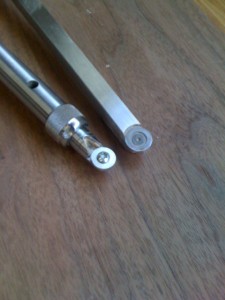We may receive a commission when you use our affiliate links. However, this does not impact our recommendations.
I learned to turn a number of years before Easy Wood Tools introduced its line of turning tools in 2010. These tools were different from more traditional turning tools – they were designed to make turning easier to learn for the beginner by greatly simplifying the techniques of how turning tools cut wood. Easy Wood tools have carbide-tipped insert tooling attached to the business end, which eliminates the need to learn how to sharpen. The tools work well and have been a hit with newbie turners; they offer an accessible way to get results without a long and sometimes-scary learning curve.
Recently, long-time turning toolmaker Robert Sorby introduced a tool called the TurnMaster that’s no doubt aimed at the same novice market. It applies the same scraping technique and insert tooling. In Sorby’s case, insert options include carbide, high-speed steel and titanium-nitride-coated high-speed steel. Like the Easy Wood tools, the Sorby TurnMaster has a flat bottom shaft designed to place on the lathe’s tool rest at all times while turning, which eliminates the need to learn how to present the proper cutting angle of the tool to the work.
The Sorby tool has an additional feature not found on the Easy Wood tools: the cutting head can rotate 45° right or left, allowing what’s called a shear scraping cut. A shear scrape can provide a much-improved finish on the wood right off the tool. Of course, the flat bottom of the tool still rests solidly on the tool rest. While this feature is great in theory, it presents a problem in use. (More on that in a minute.)
Pricing is a big factor in comparing these tools. The Sorby TurnMaster is $129 and comes with three insert cutters: square (for roughing), round (for shear cuts) and diamond-shaped (for small details). Each of these shapes fit perfectly in the tool’s uniquely designed head. They are held in place with a screw.
The Easy Wood tools are dedicated to the shape of the cutter. So, to have the same three cutting shapes that Sorby offers in one tool, you’d need to purchase three separate Easy Wood tools – the square cutter roughing tool for $124, the round finishing tool for $140 and the diamond detail tool for $130. That’s a huge difference. But that said, the Easy Wood tools are robust, heavy-duty tools with nice, long handles.
In use, I find the Sorby tool well-made but the adjustable head seems to me to cause problems rather than offer an advantage. Why? To allow the head to adjust, it must loosen and tighten via screw threads in the head and on the end of the tool’s shaft. The larger-diameter head requires the lathe’s tool rest to be positioned at least 2″ away from the work. Yes, you can turn this way – but as any turner knows, a fundamental principle is that the tool rest be positioned as close to the work as possible. This places the fulcrum point for the tool in an advantageous position because most of the considerable energy of the spinning wood is transferred to the tool, then absorbed by the tool rest rather than by the turner.
With the tool rest away from the work, I had a tendency to lift the TurnMaster handle to drop the cutting edge below the plane of the tool rest. This left both my shoulder and elbow in a position that became uncomfortable after about 30 minutes of turning. With my conventional turning tools, the cutting edge is always above the tool rest making the tool handle lower and in a more comfortable position. That also allows me to tuck my elbow close to my body to improve tool control.
The shear scrape is a great technique for finish cuts and removing minute amounts of material when refining a shape. The rotating-head feature on the Sorby will easily introduce this method to users of the tool. But learning this same technique by simply rolling the tool on edge is relatively easy with any turning tool. Because very light cuts are made when shear scraping, resting the tool on a corner of the shaft as opposed to a flat isn’t much of an issue.
Either of these tools can help the novice turner get off to a solid start while learning how to turn. Early success at any endeavor is just the encouragement the student needs.
Want to learn how to turn? Check out my DVD “Turning Basics for Furniture Makers.”
Here are some supplies and tools we find essential in our everyday work around the shop. We may receive a commission from sales referred by our links; however, we have carefully selected these products for their usefulness and quality.









I would question pigeon holing these tools as a “beginner” crutch. Haunting woodturning sites, I’ve noticed that even very experienced turners like them for the speed, ease of use, and reduced downtime because of the long lasting edge.
I totally agree, Sorby seem to be over engineering their new tools just for the sake of it. The same is true of their hollowing tool which requires excessive overhang due to their “clever” (bulky) adjustment mechanism.
The shear scraping function could have easily be sorted by mounting the cutter on a piece of 5/8″ hexagon bar, thus giving an option of flat and shear scraping in both directions.